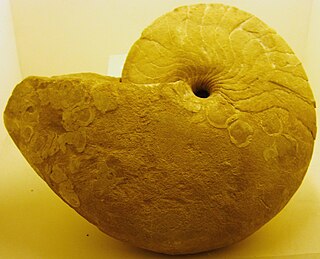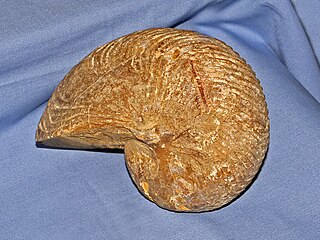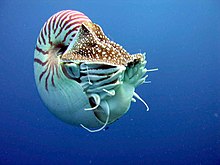
The nautilus is an ancient pelagic marine mollusc of the cephalopod family Nautilidae. The nautilus is the sole extant family of the superfamily Nautilaceae and the suborder Nautilina.

The Nautilida constitute a large and diverse order of generally coiled nautiloid cephalopods that began in the mid Paleozoic and continues to the present with a single family, the Nautilidae which includes two genera, Nautilus and Allonautilus, with six species. All told, between 22 and 34 families and 165 to 184 genera have been recognised, making this the largest order of the subclass Nautiloidea.

Nautiloids are a group of marine cephalopods (Mollusca) which originated in the Late Cambrian and are represented today by the living Nautilus and Allonautilus. Fossil nautiloids are diverse and speciose, with over 2,500 recorded species. They flourished during the early Paleozoic era, when they constituted the main predatory animals. Early in their evolution, nautiloids developed an extraordinary diversity of shell shapes, including coiled morphologies and giant straight-shelled forms (orthocones). Only a handful of rare coiled species, the nautiluses, survive to the present day.
The Nautilina is the last suborder of the Nautilida and the only nautiloids living since the end of the Triassic. The Nautilina, proposed by Shimanskiy, is basically the Nautilaceae of Kummel, 1964, defined by Furnish and Glenister, but differs in omitting two families, the Paracenoceratidae and Pseudonautilidae which instead are placed in the Liroceratina.
The Rutocertina is one of only three suborders in Shimankiy's (1957) classification of the Nautilida, the other two being the Lirocerina and Nautilina. Genera in the Rutocerina are redistributed in the Rutoceratina, Tainoceratina, and Centroceratina. The Lirocerina is redefined as the Liroceratina, and Nautilina.remains as is. In general terms these are similar to the simpler classification proposed by Kümmel 1964, wherein the Nautilida is divided into five superfamilies, the Tainocerataceae, Trigonocerataceae, Clydonautilacea, Aipocerataceae, and Nautilaceae. Shimanskiy's classification involves 34 families, Kümmel's only twenty-seven.

Aturia is an extinct genus of Paleocene to Miocene nautilids within Aturiidae, a monotypic family, established by Campman in 1857 for Aturia Bronn, 1838, and is included in the superfamily Nautilaceae in Kümmel 1964.

Cenoceras is an extinct genus within the cephalopod mollusc family Nautilidae, which in turn makes up part of the superfamily Nautilaceae. This genus has been described by Hyatt in 1884. The type species is Cenoceras intermedium, which was originally described by Sowerby 1816 as Nautilus intermedius.
Tithonoceras is a genus of nautiloid cephalopod from the Upper Jurassic found in the Crimea, belonging to the nautilacean family Paracenoceratidae.

Hercoglossidae is a family of nautilid cephalopods in the superfamily Nautilaceae. It was established by Spath in 1927 for smooth, involute nautiloids characterized by a suture with differentiated elements, known from the Upper Jurassic to the Oligocene.
The Clydonautiloidea are a superfamily within the nautiloid order Nautilida characterized by smooth, generally globular, shells with nearly straight sutures, in early forms, but developing highly differentiated sutures in some later forms. Where known, the siphuncle tends to be central to subcentral.

The Trigonoceratoidea are a superfamily within the Nautilida that ranged from the Devonian to the Triassic, thought to have contained the source for the Nautilaceae in which Nautilus is found.

The Cymatoceratidae is a family of Mesozoic and early Cenozoic nautiloid cephalopods and the most abundant of this kind in the Cretaceous. They are characterized by ribbed, generally involute shells of varied form - coiled such that the outer whorl envelops the previous, as with Nautilus, and sutures that are variably sinuous.
Syringonautilidae is a family of Nautiloidea from the middle to late Triassic. Syringonautilidae comprise the last of the Trigonoceratoidea and are the source for the Nautilaceae which continued the Nautiloidea through the Mesozoic and into the Cenozoic right down to the recent. Syringonautilidae is a strictly Triassic family, derived early in the Triassic from the Grypoceratidae.

Grypoceratidae is the longest-lived family of the Trigonoceratoidea, or of the near equivalent Centroceratina; members of the Nautilida from the Upper Paleozoic and Triassic.
The Trigonoceratidae is a family of coiled nautiloid cephalopods that lived during the period from the Early Carboniferous (Mississippian) to the Early Permian.
Liroceratidae is an extinct family of nautilids, shelled marine molluscs, belonging to the Clydonautiloidea, consisting of generally smooth, involute, nautiliconic forms with a small umbilicus. The whorl section is usually depressed and broadly rounded, the suture only slightly sinuous, and the siphuncle usually more or less central.
Pseudonautilidae is a family of Jurassic and Lower Cretaceous nautilid cephalopods belonging to the same superfamily as modern Nautilus, Nautilaceae, but forming a different branch from the family Nautilidae. Pseudonautilids, together with other nautilids, were contemporary with the ammonoids, which comprise an entirely different set of shelled cephalopod stocks more closely related to octopus and squid.

Eutrephoceras is an extinct genus of nautilus from the Late Jurassic to the Miocene. They are characterized by a highly rounded involute shell with slightly sinuous suture patterns.
Procymatoceras is a nautiloid cephalopod from the Middle Jurassic with a large, tightly involute, rapidly expanding shell. Early, inner, whorls are round in cross section. Later, outer, whorls, and mature living chamber are flattened on the sides and venter. Surface covered with sinuous ribs. Sutures have shallow ventral and dorsal lobes. Probably gave rise to Cymatonautilus and is the likely ancestor of Cymatoceras and Paracymatoceras. Procymatoceras has its origin in the earliest Nautilidae, in Cenoceras.
Somalinautilus is a genus of nautiloids that is found in the Middle to Upper Jurassic of England, France, and Somaliland. The genus contains three species, S. antiquus, first assigned to Nautilus by Dacque in 1910, S. fuscus, first assigned to Nautilus in 1898, and S. clausus, first used under Nautilus in 1890. Another species of Nautilus was named in 1905, N. bisculatus, which is now a synonym of S. antiquus.










